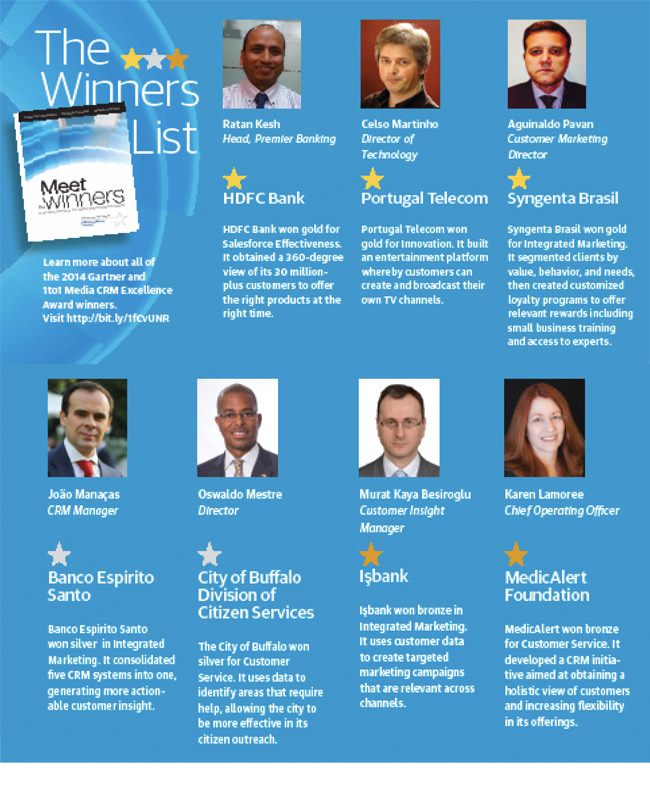In today’s highly competitive business environment, it’s important that businesses not only understand the need for continuous customer strategy improvement, but also firmly have in place the processes, strategies, and technologies to see their initiatives come to fruition.
Each year, the Gartner & 1to1 Media CRM Excellence Awards spotlight organizations that have implemented successful customer strategy and CRM initiatives and deliver optimum customer experiences. These organizations have taken a customer-centric approach to improving their business performance and are seeing positive ROI as a result.
In May, Gartner and 1to1 Media announced the 2014 winners at the Gartner Customer 360 Summit in Orlando. The staff of the Customer Strategist caught up with a few of them to discuss the details of their strategies for adapting their organizations to respond to the increasing trend of consumers intersecting with technology, the challenges in doing so, and the opportunities that have so far resulted from their efforts.
Customer Strategist: How are humans and technology intersecting in your industry and at your companies?
Karen Lamoree, MedicAlert Foundation:
Digital technology is transforming healthcare. People want information to be exchanged and to be involved in their health, all while maintaining security and privacy. Technology, whether from a systems or a product perspective, is enabling the connection.
At MedicAlert, our members want a way to integrate data from multiple sources or points of care and have a cohesive picture of their health available immediately. Although MedicAlert has been doing this since its inception, technology has enabled us to keep a record that integrates data from multiple sources and exchange that data with healthcare providers, ensuring privacy and accuracy. We also have a unique (global) identifier within our infrastructure that allows cross-referencing of information. MedicAlert also created the only first responder mobile application that can provide data to paramedics and emergency doctors in real time when it is most critical. From a product perspective, we are looking at all types of wearable technology, GPS, and/or RFID enabled products.
Ratan Kesh, HDFC Bank:
Today, technology is involved at every touchpoint within the bank. It is moving at a fast pace toward self service where customers can do everything they want to without necessarily interacting with the bank representative. In addition to various financial transactions, customers are looking to open a bank account, apply for a loan, credit card, etc. from their mobile devices and expect fast turnaround times for fulfillment. Customers also want multichannel integration wherein he/she can start a transaction in one channel (e.g. mobile apps), conclude in another channel (e.g. net banking) and then pose a query to yet another channel (call centre).

Celso Martinho, Portugal Telecom:
Technology is still primordially an enabler for achieving human-driven goals, but also a prime catalyst for behavior change.
Enablement, regardless of method, fosters better awareness of motivation and new viewpoints. Technology enablement differs only on the quality and intensity of said awareness. It provides us with better and more focused insights into our (and our customers’) behaviors and by challenging our established perceptions of what could be achieved, fosters change in behavior from inconsequential information foraging to new habits that challenge social mores.
[Our personalized TV platform] MEO Kanal demonstrates this by providing individuals and communities with a new outlet for cultural expression and an alternative to the traditional broadcast paradigm. Individuals and communities have gained access to what was usually a closed environment defended by a small group of gatekeepers—professional producers, distributors, and broadcasters. MEO Kanal uses technology exactly for this purpose, extending what was already a highly interactive TV experience in the MEO service.
Murat Kaya Besiroglu, Isbank:
As banks are significant users of financial and information technologies, technological developments are shaping the banking industry. On the other hand, rapidly increasing usage of mobile technology and alternative delivery channels by customers requires even more complex technological developments. Adapting this rapidly changing technology in a way that creates added value for customers and achieves innovations in this environment requires competent and creative human resources with a deep technological knowledge. In this respect, the importance of qualified human resources is increasing in the banking industry.
Having led the way forward in the development of alternative delivery channels with many innovations in the Turkish banking industry, Isbank engages intensively in R&D activities and efforts to make use of new technologies as well as employing qualified human resources in order to further increase the quality and diversity of the services it offers in line with customers’ needs and expectations.
Oswaldo Mestre, City of Buffalo:
In the public sector, there is a greater utilization of technology as a depository of knowledge and information. We are becoming more accustomed to storing information that is critical to our programming that outlasts the tenure of staff, and can thereby seamlessly transition from year to year without loss of quality or vision. With technology, we are more equipped to streamline processes and eliminate subjectivity inherent in program decision making. The data derived from the use of technology informs and directs processes to better serve a community and address a need.
This function is especially useful at the City of Buffalo’s Division of Citizen Services. The data captured from our technology-driven 311 Call Center directs the efforts of our neighborhood restoration initiative “Clean Sweeps.” It informs us what challenges residents are facing and we can properly disperse services that address those needs. We use technology, like our self-service option and newly created mobile app, to engage residents in this process of informing the government of the services they require. Without this form of communication, we would not be able to fully and confidently judge the needs of a community.
João Manaças, Banco Espirito Santo:
Full digitization of processes, Big Data, and mobile are now the technological driving forces of change in banking. Technology will continue to replace human routine back-office and transactional operations. That will leave time for bank staff to do what no machine can—providing the “human touch.” Machines will increasingly handle more repetitive tasks, leaving further time for bank staff to do higher value jobs, namely advisory and commercial activities.
CS: What is your company doing to prepare for further intersection?
Celso Martinho: We continue to investigate opportunities for providing simple, effective ways to use technology to take control of customers’ daily lives. We do regular focus groups and tests of the user interfaces of our technological products and try to bring new functionalities into the everyday life of our users.
Ratan Kesh: At HDFC Bank, we have created a strategy to assess every technology implementation from a customer need perspective, and how the bank should respond to their expectations. With CRMnext we are implementing an increasing number of processes on mobile platforms, which can be accessed by bank employees as well as customers in a very convenient and user-friendly way. We are creating straightforward processes for faster turnaround times, reducing rework and thereby increasing customer delight while at the same time reducing acquisition costs. We are building an integrated framework to instantly resolve customers’ doubts and concerns as part of the application and fulfillment processes.
Murat Kaya Besiroglu: We believe that our qualified human resources contribute to our ability to carry out our strategies and to achieve our objectives. They are cornerstones of our innovative corporate culture. As we continuously try to develop this innovative corporate culture, extra importance is given to training activities and development guidance to all of our employees. With the help of these qualified human resources, we are constantly trying to achieve innovations such as developing systems that can adopt certain course of actions in order to automate our operations gradually.
Karen Lamoree: MedicAlert has developed systems so it can transfer data bi-directionally, and in real time to multiple providers. We have a unique identifier that can coordinate communication and information across systems. Since MedicAlert is a charity and independent of any one system, we are in a unique position to coordinate information and engagement. We are also looking at ways to help with the continuity of care.
Oswaldo Mestre: The Division of Citizen Services is at the forefront of community engagement, which is increasingly turning toward technology as a medium to facilitate a relationship between residents and local government. The City of Buffalo is utilizing mobile apps, self-service, and the CRM system as a whole to lead the movement towards greater intersection in the public sector. However, the end user guides the development and degree of integration of the technology in this process. Their guidance helps us to create a user-friendly version, which ultimately increases engagement and creates a larger pool of data for us to make programming decisions.
CS: What’s the biggest challenge to making ideas a reality?
Oswaldo Mestre: The biggest obstacle in making an idea a reality is ensuring that your idea is plausible for the environment you are working in. Ideas can be well thought out and good intentioned, but not relevant or necessary. It’s imperative that you “put your ear to the rails to hear what’s coming.” You need to anticipate problems as well as opportunities to implement ideas that serve a purpose for a neighborhood. Your stumbling block will always be push back from the residents you serve, if you operate outside of their needs or desires. Therefore having their buy in, by including them in the process of developing and shaping your idea, will propel your idea into a reality.
Aguinaldo Pavan, Syngenta Brasil: Aligning the speed of technology developments and the speed of adoption in our market. That requires lots of training, processes, and focus on return of investments.
Murat Kaya Besiroglu: Accelerating change in technological developments makes certain issues such as rapid accomplishment of innovations and accurate timing highly critical. On the other hand, as customer needs and expectations are increasing, products and channels are becoming more sophisticated. This environment itself is the biggest challenge to put ideas into action and only integrity, dedication, and focus could overcome this challenge.
Ratan Kesh: Getting multiple stakeholders involved and building consensus over various processes to implement a system of such a scale and complexity continues to be a challenge and more so because the bank continues to grow at a rapid pace.
Celso Martinho: Dogma and its associated inflexibility. Technology in and of itself cannot be applied without a cultural foundation based on openness to debate and methodical questioning. A suitable company culture is the fulcrum for leveraging change and pursuing new ideas.
Karen Lamoree: For MedicAlert, it’s finding partners who share the same vision of the future. We interact with a wide demographic, all with different needs and wants. It’s about integrating technology to make things easier while continuing the confidence in the integrity of data.
CS: What potential future are you most excited about?
Karen Lamoree: We need to think differently about everyday activities and items like exchange of data, communication, and engagement with our members, and products that convey the critical information. There is great opportunity to have all of your information cohesively in one place and available when you want it (or need it). The evolving wearable products and GPS-enabled products are exciting to us since they integrate personal information and technology.
João Manaças: Customer behaviors and expectations are changing and new digital banks are trying hard to modify the rules. To stay ahead, traditional banks must adapt quickly. I recommend banks:
• Set a clear vision of its future strategic position as a bank and define an implementation roadmap
• Develop a dual strategy for two very different customer segments: the small but growing “self directed” customers and the large but shrinking “branch lovers”
• Assure a consistent, omnichannel channel experience
• Define an IT strategy for the transition: from complex and outdated legacy systems with still many semi-automated processes to a new full digital bank
Ratan Kesh: We see mobility, social media, and Big Data as big opportunities to create smarter customer-centric processes. These will also help to reduce transaction costs, increase cross-sell capabilities, and help to maximize customer life cycle value.
Murat Kaya Besiroglu: The biggest opportunity and also the most exciting part of human and technology intersection is the potential for automation of decision processes for customer interactions gradually over the years. In order to fully achieve this potential, human resources who master both retail banking business and IT are essential.
Using social media, digital banking channels, and other Internet mediums, customers are interacting more and more with banks. Crowdsourcing activities aroused from this customer participation show great potential for optimizing and aligning customer services as well as achieving further innovations.
Oswaldo Mestre: The biggest opportunity from this intersection is increased productivity and better customer service. Technology assists in the delivery of city services and allocates them appropriately to areas demonstrating the most need. The more residents engage technology to report quality of life issues the better the city can respond to those issues in an efficient and coordinated manner. Eventually, the City of Buffalo will capture enough data to leverage with other organizations and openly display this data. This availability of information will allow residents to be better informed and feel confident in the progress local government is making in areas of concern.






